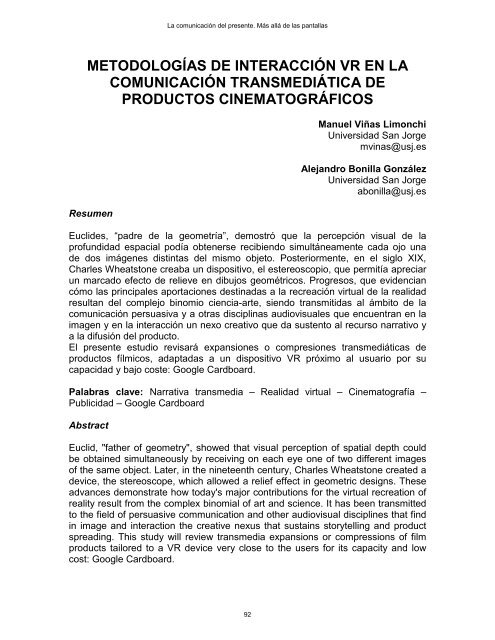LA COMUNICACIÓN DEL PRESENTE MÁS ALLÁ DE LAS PANTALLAS
libro2016
libro2016
Create successful ePaper yourself
Turn your PDF publications into a flip-book with our unique Google optimized e-Paper software.
La comunicación del presente. Más allá de las pantallas<br />
METODOLOGÍAS <strong>DE</strong> INTERACCIÓN VR EN <strong>LA</strong><br />
<strong>COMUNICACIÓN</strong> TRANSMEDIÁTICA <strong>DE</strong><br />
PRODUCTOS CINEMATOGRÁFICOS<br />
Resumen<br />
Manuel Viñas Limonchi<br />
Universidad San Jorge<br />
mvinas@usj.es<br />
Alejandro Bonilla González<br />
Universidad San Jorge<br />
abonilla@usj.es<br />
Euclides, “padre de la geometría”, demostró que la percepción visual de la<br />
profundidad espacial podía obtenerse recibiendo simultáneamente cada ojo una<br />
de dos imágenes distintas del mismo objeto. Posteriormente, en el siglo XIX,<br />
Charles Wheatstone creaba un dispositivo, el estereoscopio, que permitía apreciar<br />
un marcado efecto de relieve en dibujos geométricos. Progresos, que evidencian<br />
cómo las principales aportaciones destinadas a la recreación virtual de la realidad<br />
resultan del complejo binomio ciencia-arte, siendo transmitidas al ámbito de la<br />
comunicación persuasiva y a otras disciplinas audiovisuales que encuentran en la<br />
imagen y en la interacción un nexo creativo que da sustento al recurso narrativo y<br />
a la difusión del producto.<br />
El presente estudio revisará expansiones o compresiones transmediáticas de<br />
productos fílmicos, adaptadas a un dispositivo VR próximo al usuario por su<br />
capacidad y bajo coste: Google Cardboard.<br />
Palabras clave: Narrativa transmedia – Realidad virtual – Cinematografía –<br />
Publicidad – Google Cardboard<br />
Abstract<br />
Euclid, "father of geometry", showed that visual perception of spatial depth could<br />
be obtained simultaneously by receiving on each eye one of two different images<br />
of the same object. Later, in the nineteenth century, Charles Wheatstone created a<br />
device, the stereoscope, which allowed a relief effect in geometric designs. These<br />
advances demonstrate how today's major contributions for the virtual recreation of<br />
reality result from the complex binomial of art and science. It has been transmitted<br />
to the field of persuasive communication and other audiovisual disciplines that find<br />
in image and interaction the creative nexus that sustains storytelling and product<br />
spreading. This study will review transmedia expansions or compressions of film<br />
products tailored to a VR device very close to the users for its capacity and low<br />
cost: Google Cardboard.<br />
92


